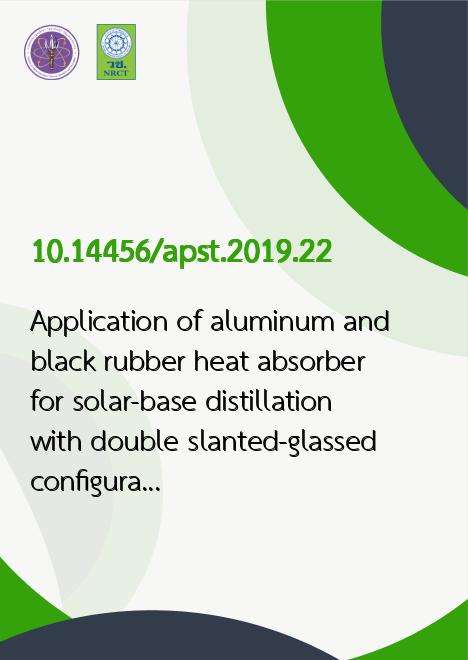
|
Application of aluminum and black rubber heat absorber for solar-base distillation with double slanted-glassed configuration |
|---|---|
| รหัสดีโอไอ | |
| Creator | Nattadon Pannucharoenwong |
| Title | Application of aluminum and black rubber heat absorber for solar-base distillation with double slanted-glassed configuration |
| Contributor | Nattadon Pannucharoenwong, Phadungsak Rattanadecho, Victoria Timchenko, Snunkhaem Echaroj, Kriengkrai Nabudda |
| Publisher | Asia-Pacific Journal of Science and Technology |
| Publication Year | 2562 |
| Journal Title | Asia-Pacific Journal of Science and Technology |
| Journal Vol. | 24 |
| Journal No. | 3 |
| Page no. | 1-11 |
| Keyword | Distillation unit, Heat transfer, Heat absorber, Solar radiation |
| URL Website | https://www.tci-thaijo.org/index.php/APST |
| Website title | https://www.tci-thaijo.org/index.php/APST/article/view/177033/151324 |
| ISSN | 2539-6293 |
| Abstract | The aim of this research is to generate a mathematical model and investigate the efficiency of aluminum and black rubber as heat absorber for the Solar-based Double one-Direction slanted-Glass distillation unit (SDDG) by varying the size of the heat absorber. The heat absorber was placed inside the secondary liquid layer of the distillation station. Experiments were conducted by varying the heat absorber plate from 10% to 90% of the second layer's area. The volume of distilled water was monitored to calculate the efficiency of the distillation unit. Results showed the highest distilled volume of 1.60 litre per day was obtained when the size of aluminum heat absorber was 10%, which produced an average efficiency of 26.34%. Furthermore, a reduction in the distilled volume and efficiency to 0.98 litre per day and 17.3% was observed when the aluminum heat absorber size was increased to 90%. The same trend can be observed for SDDG with black rubber as a heat absorber. However, the efficiency of equivalent size of black rubber is significantly smaller than aluminum due to lower thermal conductivity and material shrinkage when exposed to the solar radiation. The maximum productivity achievable for SDDG with black rubber heat absorber was only 1.17 litre per day. This indicated better heat transfer for smaller heat absorber. The reason is because it is harder for light to pass through the heat absorber with larger area causing the efficiency to drop dramatically as area of heat absorber increased. Polynomial equations were successfully proposed for prediction of productivity from operating time and efficiency from the size of heat absorber. |